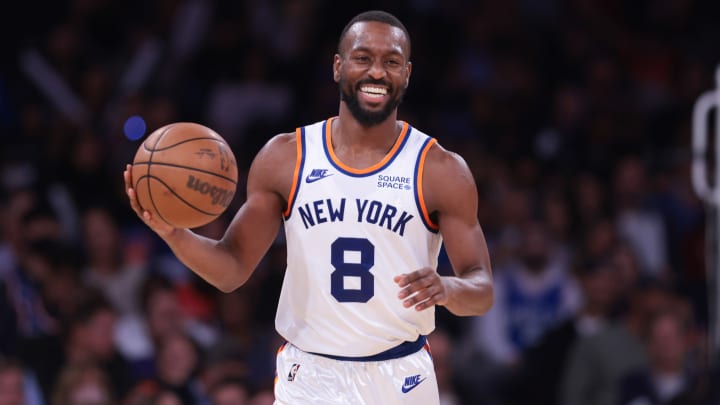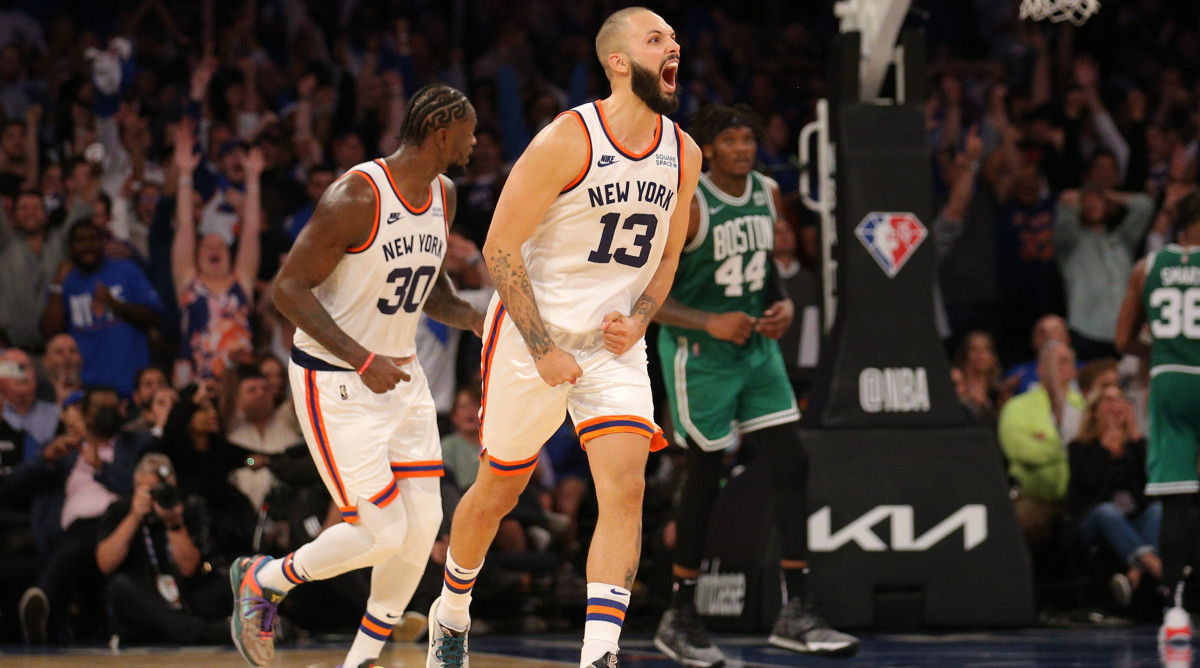Behind the Knicks' Drastic Change That Has New York Rising in East

In a topsy-turvy season like this, in which the Bulls and the Hornets are leading the East one week in, and the Timberwolves find themselves near the top of the West, it might sound overblown to refer to the Knicks as one of the NBA’s most overhauled teams.
Yet coach Tom Thibodeau’s club, which last season earned home court advantage and this offseason brought back the vast majority of its roster, looks totally different so far. And it stems from the Knicks dialing things up from long distance.
Through their first four games, the Knicks are launching from deep 46 times per night. Aside from that outpacing any other team in the league, New York’s three-point jump from last year is one of the most drastic in NBA history. The Knicks took only 30 shots from three a season ago, meaning their attempts per game are up by more than 53%.
Heading into Thursday’s showdown with the undefeated, new-look Bulls, 48.4% of the Knicks’ shot attempts have been threes. In terms of attempt rate, that jump—from just 34.7% last year—stands as the NBA’s third-biggest of all time, according to our friends at Stats Perform.
Largest Improvements in 3PT Rate — All-Time
(Three-point line introduced in 1979–80)
SZN_RANGE | TEAM | PCT_YR1 | PCT_YR2 | DIFF | REC_YR1 | REC_YR2 |
|---|---|---|---|---|---|---|
2006-07 -> 2007-08 | Magic | .158 | .322 | 0.164 | 40-42 | 52-30 |
2015-16 -> 2016-17 | Nets | .218 | .371 | 0.153 | 21-61 | 20-62 |
2020-21 -> 2021-22 | Knicks | .347 | .484 | 0.137 | 41-31 | 3-1 |
2014-15 -> 2015-16 | Hornets | .226 | .348 | 0.122 | 33-49 | 48-34 |
2017-18 -> 2018-19 | Bucks | .297 | .419 | 0.122 | 44-38 | 60-22 |
1993-94 -> 95 | Hawks | .118 | .237 | 0.119 | 57-25 | 42-40 |
The opened-up style of play illustrates one way the Knicks can hold their own in what looks to be a vastly improved Eastern Conference. There was plenty of offseason chatter about whether the Knicks did enough to tweak their roster following what could have been seen as a fluky, COVID-19–riddled campaign where New York caught everyone by surprise. The team’s over/under was remarkably pedestrian, projected to be around .500 in some sportsbooks.
Similar to how things looked nine years ago, when the team experimented with a heavy three-point arsenal in the 2012 preseason before breaking an NBA record for triples attempted in a season on the way to a surprising 54–28 campaign, there were strong indications that these Knicks would look much different on offense from last year’s version.
But it’s important to note that it’s not just the shots from deep that have altered the offense. It’s also the skill sets of the players that have made the extra looks from distance possible.

Ironically, the shift was made possible in part by replacing last year’s biggest spot-up threat (Reggie Bullock, who launched a team-high six threes per game and hit them at a 41% clip) with free agent Evan Fournier, a far more versatile playmaker and slasher. But even with all the playmaking and slashing, Fournier is unleashing almost nine three-point tries per game (and hitting 45.7% of them), a massive number for a player using well under a quarter of his team’s possessions.
He’s often been the beneficiary of playing alongside All-Star Julius Randle, who draws more defensive attention. (So far, 29.3% of Fournier’s three-point attempts have been wide open, with no defender standing within six feet of him, according to NBA.com.) But even when opposing clubs smother Fournier with hard closeouts, he’s more equipped to make something happen in those scenarios. So far, he’s gotten to the free throw line about twice as frequently as Bullock did, and, at 6' 7", he's shot 9-of-12 in the restricted area.
Yet you can’t talk about the Knicks’ offensive transformation without discussing the other backcourt swap: Losing starter Elfrid Payton and picking up Bronx native Kemba Walker.
It’s hard to begin even drawing contrasts between the guards, given how vastly different they are. Payton having a reputation as a stopper, but having several shortcomings as a creator and scorer, while Walker—charge-drawing aside—isn’t the best on D, but essentially became famous for his ability to create space as a scorer.
Opponents often left Payton alone in the corner, preferring to double Randle when the two shared the court. The presence of Walker, who’s long been one of the league’s most difficult pick-and-roll guards to defend, makes it nearly impossible to gamble that way. (Walker has played about 7% of the minutes that Payton did, yet with 13 triples, he’s already made nearly half as many threes as Payton did all of last season.) Unlike with Payton, stoppers can’t go under the screen, as it gives Walker a clear look at the basket. Going over the screen too aggressively causes problems, too, as Walker became one of the NBA’s best foul drawers on three-point attempts by getting contact from trailing defenders.
The dilemma has often resulted in two defenders going with Walker in screen-and-roll situations, inevitably leaving someone else open along the perimeter. That sort of upgrade—and the process of getting easier shots—is likely what the Knicks had in mind in trying to stave off a team-wide shooting regression after collectively shooting the cover off the ball last season.
This isn’t to suggest the team doesn’t have its share of potential pitfalls. Third-year forward R.J. Barrett could stand to become far more consistent as a shooter from one half to the next. The new backcourt isn’t as big or as good defensively, as shown in the closing moments of regulation in that crazy double-overtime win over Boston. And while the team is thrilled to have spacing threat and swat artist Mitchell Robinson back in the lineup, each time he takes a spill on the court is cause for concern at this point. The depth behind him is Nerlens Noel, who’s yet to play this season due to a knee injury, and 36-year-old backup Taj Gibson.
Still, it was well understood that this team wasn’t going anywhere if it didn’t find a way to upgrade its offense after sputtering against the Hawks in the first round last year. And for what it’s worth, this engine looks retooled—perhaps enough to where the first round will be just the beginning of the journey as opposed to the end of the road.
More NBA Coverage:
• NBA Power Rankings: First Impressions for All 30 Teams
• 10 Early NBA Season Trends to Watch
• The NBA 75: Biggest Snubs, Surprises and Ranking Best Players
• How Chicago Became the NBA's Most Intriguing Team
